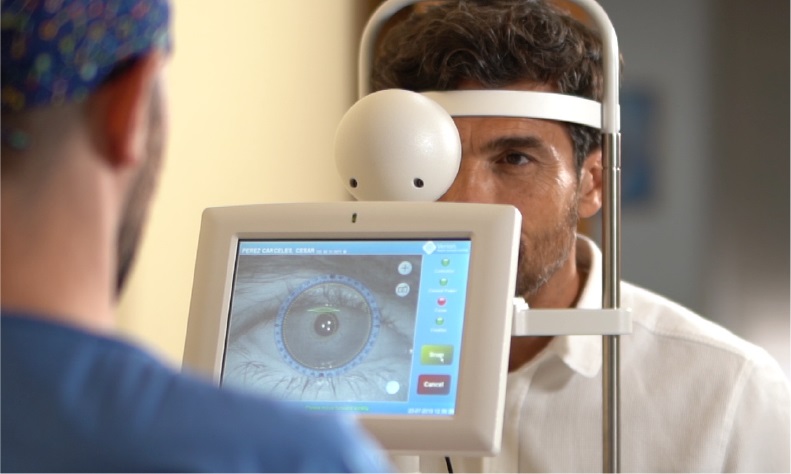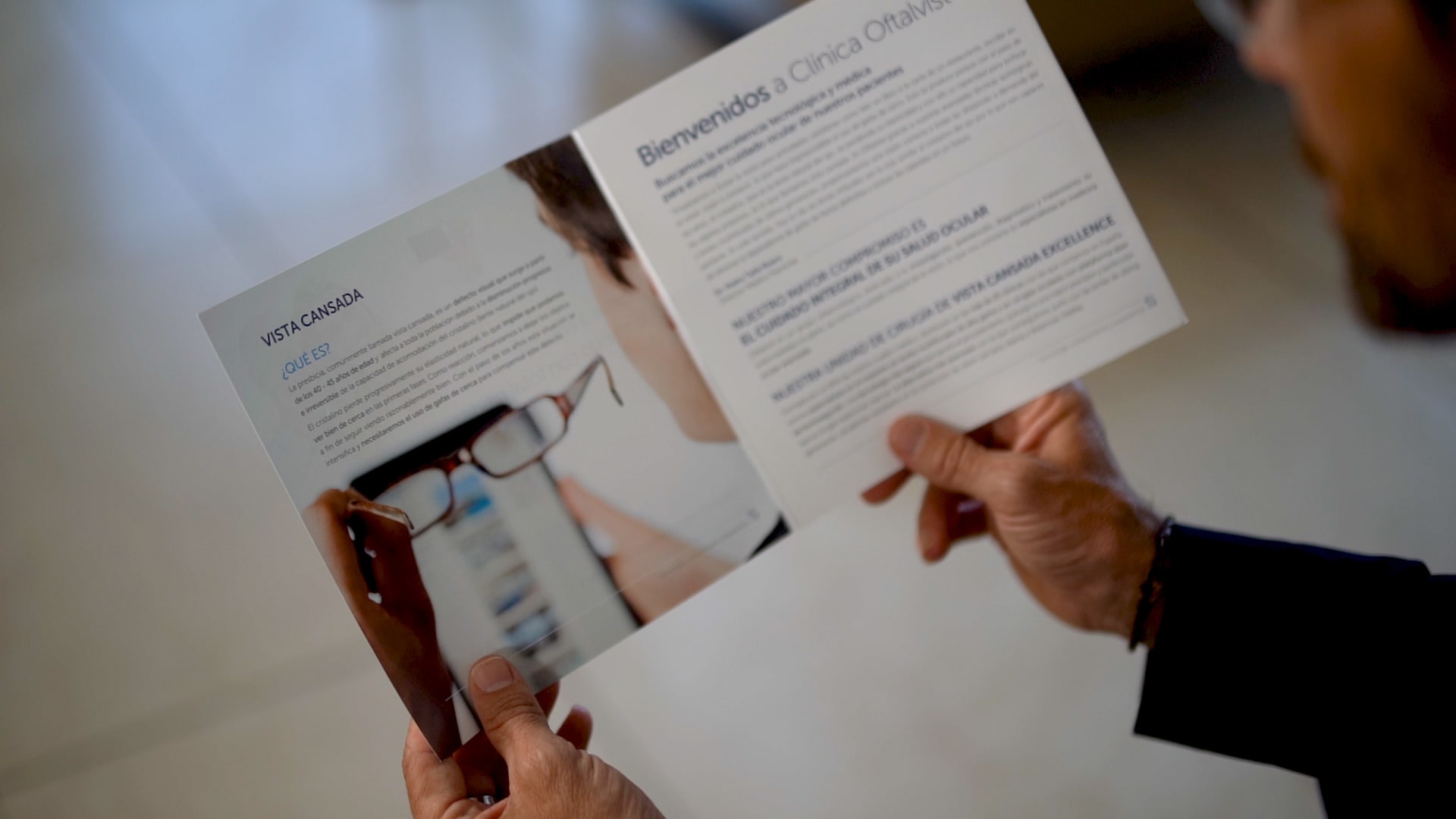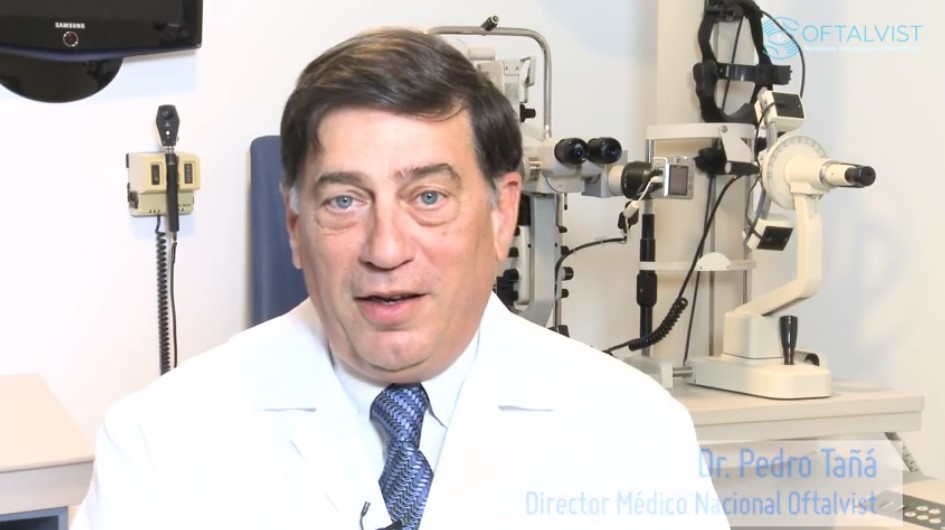Presbyopia / Presbyopia
What is presbyopia?
Presbyopia is a visual anomaly that generally occurs between the ages of 45 and 50 and affects 100% of the population. It occurs as a result of a progressive and irreversible reduction in the accommodation capacity of the crystalline lens, the eye’s natural lens, which is responsible for automatically focusing the eye at any distance (accommodation).
The crystalline lens therefore loses its natural elasticity, preventing the patient from seeing clearly up close in the early stages. The situation will deteriorate over the years and we will need to use reading glasses to compensate for this deficiency.
From the age of 55, the presbyopia may reach a maximum value of +3.00 dioptres, which is the maximum that the crystalline lens can focus.
As with cataracts, presbyopia is associated with the natural aging of our eyes, so it is therefore not possible to prevent it. The only current solution is surgery.

According to different studies, between 85% and 95% of the population suffers from presbyopia from the age of 45, around of more than 17 million Spanish.
Causes of presbyopia
Presbyopia is a visual condition that develops as a result of the normal aging of the crystalline lens, the eye’s natural lens, whose primary role is to focus at all distances.
Its occurrence is therefore closely linked with age, as opposed to patients who suffer from hyperopia, which causes their near vision to deteriorate and is largely triggered by environmental and genetic factors, in addition to the corneal curvature.
● As the crystalline lens progressively thickens and loses its elasticity, the eye loses its ability to focus up close during the early stages, which consequently leads to presbyopia.
● Age is therefore the primary factor that causes this hardening of the muscle fibres and tissue in and around the crystalline lens, which grows over the years and becomes harder.
● It should be noted that presbyopia is not an illness that randomly affects some people but not others, it is a normal physiological process that will eventually affect 100% of the population.
Symptoms of presbyopia
One of the main symptoms is blurry vision, which generally becomes evident when patients with presbyopia need to move back from an object or written material, or hold it further away in order to focus on it properly, as the process for changing between near and distance focus, and vice versa, has been slowed down.
Early signs of presbyopia in everyday situations could be if the following appears blurry:
→ Letters on the screen of any electronic device: mobile phone, computer or tablet.
→ Books, restaurant menus, labels on food packaging.
→ Threading the eye of a needle.
→ Headache or eye strain when you are making too much effort to focus so you can see more clearly, particularly later in the day.
As with the progressive difficulty focusing on objects close up, the crystalline lens will also lose its ability to compensate for existing visual defects (e.g. hyperopia and astigmatism), so the person may also notice that their distance vision deteriorates at the same time.
The problems focusing up close will get progressively worse until around 60 years old, where it will stabilise. Until that point, the prescription for progressive reading glasses will need to be adjusted every 2-3 years so the patient can focus properly.
After around 60 years old, over the years the patient may lose the need to use glasses for the aforementioned activities, such as reading and sewing, a phenomenon known as second sight, a very common symptom that precedes the appearance of cataracts.
Preoperative tests for presbyopia surgery
If you suspect you might be suffering from presbyopia, it is a good idea to see a specialist ophthalmologist so they can perform a comprehensive ophthalmology exam to check the condition of your eyes and confirm the diagnosis.
This eye examination is simple, painless and reliable as long as it is performed using the appropriate diagnosis techniques:
Once all the results of these tests have been obtained, the ophthalmologist specializing in surgery for presbyopia or tired eyesight in the consultation will explain in detail whether or not you are a candidate for surgical intervention, as well as which are the most appropriate options if you are thinking of correcting his presbyopia.
Measurement of intraocular pressure. |
Test for visual acuity and prescription. |
Examination of the anterior and posterior segments of the eye. |
Endothelial cell count in both eyes. |
Macula OCT test in both eyes. |
A detailed study of the eyes: corneal topography, aberrometry, corneal pachymetry and laser biometry. |
Frequently asked questions
→ Presbyopia: does it affect all human beings?
It is one of the most common vision disorders and affects 100% of the Spanish population over the age of 50 years old. It is part of the eye’s natural aging process, but, fortunately, it can now be treated early and more safely through surgery.
→ How is presbyopia corrected?
→ When might presbyopia occur?
→ When is a good time to have presbyopia surgery?
→ Can I undergo presbyopia surgery if I have myopia, hyperopia or astigmatism?
→ How is presbyopia diagnosed?
→ Why perform surgery with femtosecond laser technology?
→ What is premature presbyopia?
→ What is premature presbyopia?
→ Will I be asleep during the surgery?
→ Can both eyes be operated on at the same time?
→ What is a trifocal lens?
→ If I undergo presbyopia surgery, can I also have cataract surgery in the future?
→ How can presbyopia be prevented?






